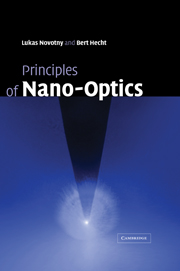Book contents
- Frontmatter
- Contents
- Preface
- 1 Introduction
- 2 Theoretical foundations
- 3 Propagation and focusing of optical fields
- 4 Spatial resolution and position accuracy
- 5 Nanoscale optical microscopy
- 6 Near-field optical probes
- 7 Probe–sample distance control
- 8 Light emission and optical interactions in nanoscale environments
- 9 Quantum emitters
- 10 Dipole emission near planar interfaces
- 11 Photonic crystals and resonators
- 12 Surface plasmons
- 13 Forces in confined fields
- 14 Fluctuation-induced interactions
- 15 Theoretical methods in nano-optics
- Appendix A Semianalytical derivation of the atomic polarizability
- Appendix B Spontaneous emission in the weak coupling regime
- Appendix C Fields of a dipole near a layered substrate
- Appendix D Far-field Green's functions
- Index
7 - Probe–sample distance control
Published online by Cambridge University Press: 05 June 2012
- Frontmatter
- Contents
- Preface
- 1 Introduction
- 2 Theoretical foundations
- 3 Propagation and focusing of optical fields
- 4 Spatial resolution and position accuracy
- 5 Nanoscale optical microscopy
- 6 Near-field optical probes
- 7 Probe–sample distance control
- 8 Light emission and optical interactions in nanoscale environments
- 9 Quantum emitters
- 10 Dipole emission near planar interfaces
- 11 Photonic crystals and resonators
- 12 Surface plasmons
- 13 Forces in confined fields
- 14 Fluctuation-induced interactions
- 15 Theoretical methods in nano-optics
- Appendix A Semianalytical derivation of the atomic polarizability
- Appendix B Spontaneous emission in the weak coupling regime
- Appendix C Fields of a dipole near a layered substrate
- Appendix D Far-field Green's functions
- Index
Summary
In near-field optical micro-copy, a local probe has to be brought into close proximity to the sample surface. Typically, the probe–sample distance is required to be smaller than the size of lateral field confinement and thus smaller than the spatial resolution to be achieved. As in other types of scanning probe techniques, an active feedback loop is required to maintain a constant distance during the scanning process. However, the successful implementation of a feedback loop requires a sufficiently short-ranged interaction between optical probe and sample. The dependence of this interaction on probe–sample distance should be monotonous in order to ensure a unique distance assignment. A typical block-diagram of a feedback loop applied to scanning probe microscopy is shown in Fig. 7.1. A piezoelectric element P(ω) is used to transform an electric signal into a displacement, whilst the interaction measurement I(ω) takes care of the reverse transformation. The controller G(ω) is used to optimize the speed of the feedback loop and to ensure stability according to well-established design rules. Most commonly, a so-called PI controller is used, which is a combination of a proportional gain (P) and an integrator stage (I).
Using the (near-field) optical signal itself as a distance-dependent feedback signal seems to be an attractive solution at first glance. However, it turns out that: (1) In the presence of a sample of unknown and inhomogeneous composition, unpredictable variations in the near-field distribution give rise to non-monotonous distance dependence.
- Type
- Chapter
- Information
- Principles of Nano-Optics , pp. 225 - 249Publisher: Cambridge University PressPrint publication year: 2006



